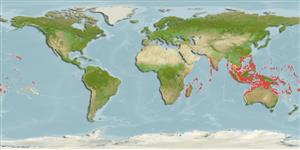>
Acanthuriformes (Surgeonfishes) >
Acanthuridae (Surgeonfishes, tangs, unicornfishes) > Acanthurinae
Etymology: Ctenochaetus: Greek, kteis, ktenos = comb + Greek, chaite = hair (Ref. 45335); binotatus: Name from Latin 'bi' meaning two and 'notatus' meaning marked; referring to the black spots at the rear base of the dorsal and anal fins.
More on author: Randall.
Environment: milieu / climate zone / depth range / distribution range
Écologie
marin récifal; profondeur 0 - 60 m (Ref. 128797), usually 10 - 50 m (Ref. 27115). Tropical; 24°N - 34°S, 29°E - 122°W
Indo-Pacific: East Africa to the Tuamoto Islands, north to southern Japan, south to central New South Wales (Australia) and New Caledonia. Not known from the Red Sea, Gulf of Oman, the Gulf, the Hawaiian Islands, Marquesas, Rapa, Pitcairn Islands, and Easter Island.
Taille / Poids / Âge
Maturity: Lm ? range ? - ? cm
Max length : 22.0 cm TL mâle / non sexé; (Ref. 5213)
Épines dorsales (Total) : 8; Rayons mous dorsaux (Total) : 24 - 27; Épines anales: 3; Rayons mous anaux: 22 - 25. Prominent black spot at the rear base of dorsal and anal fins; adults with a bluish ring around the eye (Ref 1602). Dorsal and anal fins dark brown. Caudal fin brown in adults, yellow in young. Edge of lips smooth. Upper teeth usually with 5 denticulations (not including tip). Anterior gill rakers 23-29 (Ref 42056).
Inhabits coral and rubble areas of deep lagoon and seaward reefs. Usually solitary, grazing on surface algae (Ref. 90102). Feeds by scooping film of detritus and unicellular algae (e.g. dinoflagellate Gambierdiscus toxicus) that produce ciguatera toxin making this species a key link in the ciguatera food chain (Ref. 1602, 48637). Caught with nets (Ref. 30573).
Life cycle and mating behavior
Maturité | Reproduction | Frai | Œufs | Fécondité | Larves
Randall, J.E and K.D. Clements, 2001. Second revision of the surgeonfish genus Ctenochaetus (Perciformes: Acanthuridae), with descriptions of two new species. Indo-Pac. Fish. (32):33 p. (Ref. 42056)
Statut dans la liste rouge de l'IUCN (Ref. 130435: Version 2024-2)
Utilisations par l'homme
Pêcheries: commercial; Aquarium: Commercial
Outils
Articles particuliers
Télécharger en XML
Sources Internet
Estimates based on models
Preferred temperature (Ref.
123201): 24.5 - 28.9, mean 27.7 °C (based on 1034 cells).
Phylogenetic diversity index (Ref.
82804): PD
50 = 0.5020 [Uniqueness, from 0.5 = low to 2.0 = high].
Bayesian length-weight: a=0.03388 (0.02171 - 0.05288), b=2.93 (2.80 - 3.06), in cm total length, based on LWR estimates for this species & (Sub)family-body (Ref.
93245).
Niveau trophique (Ref.
69278): 2.0 ±0.00 se; based on food items.
Résilience (Ref.
120179): Haut, temps minimum de doublement de population inférieur à 15 mois (Preliminary K or Fecundity.).
Fishing Vulnerability (Ref.
59153): Low vulnerability (12 of 100).
Nutrients (Ref.
124155): Calcium = 34.7 [21.3, 57.7] mg/100g; Iron = 0.248 [0.133, 0.599] mg/100g; Protein = 18.1 [16.8, 19.3] %; Omega3 = 0.13 [0.08, 0.21] g/100g; Selenium = 21.9 [12.8, 39.9] μg/100g; VitaminA = 44.8 [10.4, 180.9] μg/100g; Zinc = 0.382 [0.283, 1.300] mg/100g (wet weight); based on
nutrient studies.
